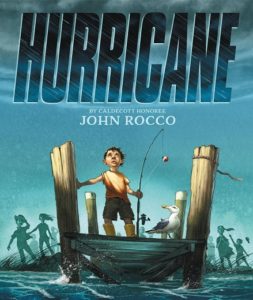This month’s PB review is by Ryan G. Van Cleave (Owner/Operator of Only Picture Books) and Ringling College of Art and Design Illustration Professor (and OPB pal) David C. Gardner.
–Ryan’s Review of the Writing–
I chose this book to review because John Rocco’s art is consistently luscious and delightful (I enlisted David Gardner to explain the hows and whys below!), and Rocco’s new picture book, Hurricane, is no exception. What grabbed me on the first page of text is how the boy walking to the end of a decrepit dock remarks “It’s very old and splintery.” Wow, that last word is spot-on. It’s the sort of exactitude of language I don’t encounter often enough in picture books by author-illustrators.
The boy we’re following in the story returns home after a lovely day of fishing and swimming off that dock to find his dad boarding up the house in preparation for a hurricane. Does the father seem a bit too calm (both in his visual appearance and not using an exclamation point in telling the boy to go inside)? Maybe. Being in Florida for more than a decade now, I know all about hurricanes–intimately so. I’m not a fan of seeing the boy with his face pressed up against a top-story window during the actual storm. That’s dangerous stuff, I’m afraid, since windows are very susceptible to blowing out in hurricanes. Plus, we just saw the dad boarding up the downstairs window for safety reasons. In a hurricane, EVERY window is a source of danger. Rocks and debris get kicked up and fly around like bullets–any one of them could shatter any window at any time.
But again, in this very same moment where the boy looks out at the storm from the upstairs window, the language is once more quite evocative: “The rain doesn’t fall in drops–it slashes sideways as if shot from a fire hose.”
I don’t want to harp on bad parenting in a picture book, BUT letting the boy outside in the post-storm wreckage of the neighborhood the next morning (witness flooding, felled trees, and damaged houses!)? That’s hard to swallow in this age of helicopter parenting or just general common sense. I fully appreciate that it’s a story about a child, so getting adults out of the way is helpful in terms of keeping it the child’s story, but this stops me. There’s not a single adult anywhere when he first goes outside. Yes, he could’ve sneaked out before anyone noticed, though adults tend to go outside to assess damage the moment it’s safe to do so.
I often think about the obligations of authors and illustrators in picture books. While we don’t want to make our stories too didactic, can we err too much on the other side by having kids so completely in their own kid-world bubble that they miss growth opportunities or seem to exist in a world that’s not quite our own? Maybe I’ve seen too many big Florida storms to easily buy into the casual response here in an otherwise real-world setting with realistic characters. Maybe picture books should be more aspirational and inspirational than realistic? Or maybe we can do all three at once? It’s an interesting conundrum for sure for which there’s no easy answer.
The boy is quite concerned with how the “monster”–meaning the storm–gobbled up the dock he loved so much. Since no one else ever used that dock, it easily explains why everyone has more pressing things to do than deal with that ruined dock. So, the boy decides he’ll try to fix it. That’s a lovely moment since the dock is so special to him and him alone. It’s almost like a friend who needs help.
I won’t spoil the ending, but there’s a strong sense of community in play through both words and visuals–it’s quite compelling. I’m also charmed by the back matter, which includes an image of a note the author wrote at six years old.
To Mom and Dad–
I have gone fishing. I will come back with a fish. John
P.S. I hope I will come back with a fis!
In quality STEAM fashion, readers are also given double-page spreads that reveal how both a dock and a hurricane work. Like the rest of the illustrations in this story, these schematic-like images are impressive and memorable.
This is a gorgeous picture book that feels visually on par with Rocco’s other fine titles (including an OPB favorite, Blackout). The story feels somewhat less potent in comparison, however. Overall, this is a fine book that can spark useful discussions about dangerous weather, community, and fear, as well as kids who have “secret” places. And do I need to mention yet again how fine the images are? Rocco is a supremely talented visual storyteller.
4.25 out of 5 pencils
–David’s Review of the Illustrations–
John Rocco is perhaps best well-known for his beloved, iconic illustrations for the Percy Jackson book series, so it’s no surprise that his cover for Hurricane is a knockout.
The cover promises a dramatic story: the low camera angle, the slash of lighting across the boy on the pier, the monochromatic background and characters in near silhouette in poses suggesting urgent anticipation of something terrible. The hurricane is referred to as a “monster” in the text, and the kids on the cover could easily be witnessing the arrival of Godzilla.
The story unfolds cinematically, shifting from wide shots to close-ups. Small panels, like storyboards, show progression. The depiction of the river creeping up the street is clear and exciting––we see the boy’s point-of-view looking through his window. Like a fixed camera shot, the first picture shows a red car in the rain, the second shows the same car, flood water rising fast all around it.
Plenty of generous double spreads are put to good use. I found two layouts especially effective: The hurricane devastating the boy’s street, full-bore, and the boy dreaming of the ocean creatures stirred up and sailing beneath his pier. It’s a moment filled with wonder.
Rocco is at the forefront of the visual storytellers who currently work in children’s books and in visual development for animation. His extensive work as a concept artist for studios like Dreamworks is evident. Mood and emotions are essential elements in concept art, and they are conveyed masterfully in Hurricane, from the sunny beginning to the turbulent storm to a sparkling, hopeful resolution.
Much of this is in his depiction of light––the changes from blue skies and French vanilla clouds to the shadowy, dimly lit, desaturated palette of the storm. For the aftermath, light sparkles on the calm water in a lovely, well-observed play of light.
The painted effects, done in watercolor, line and digital painting, are delightful. Wind and rain, tumbling leaves, waves and splashes––there’s is dynamic movement on every page. Rocco’s loving and carefully studied rendering of water, clouds, the swirl of debris, and the details of the smallest props, such as the boys rod-and-reel, all ground the story in a realistic setting, which heightens the impact of the storm.
A recurring seagull character adds a funny (but believable) lighthearted touch. Technical illustrations describing hurricane formation and pier construction serve as bookends. They’re not essential to the story, but they round the book out into a perfect study guide for classrooms.
4.5 out of 5 crayons
 David C. Gardner is an award-winning illustrator and visual development artist. A former artist for Walt Disney Animation Studios, he has illustrated numerous picture books, including his latest from Sleeping Bear Press, Write On, Irving Berlin! by Leslie Kimmelman (which appeared on OPB in May 2018). It tells the true story of little Izzy Baline, who immigrated to New York City in 1893 and grew up to become Irving Berlin, one of the most well-known composers of popular music in America. David teaches illustration at Ringling College of Art and Design.
David C. Gardner is an award-winning illustrator and visual development artist. A former artist for Walt Disney Animation Studios, he has illustrated numerous picture books, including his latest from Sleeping Bear Press, Write On, Irving Berlin! by Leslie Kimmelman (which appeared on OPB in May 2018). It tells the true story of little Izzy Baline, who immigrated to New York City in 1893 and grew up to become Irving Berlin, one of the most well-known composers of popular music in America. David teaches illustration at Ringling College of Art and Design.

